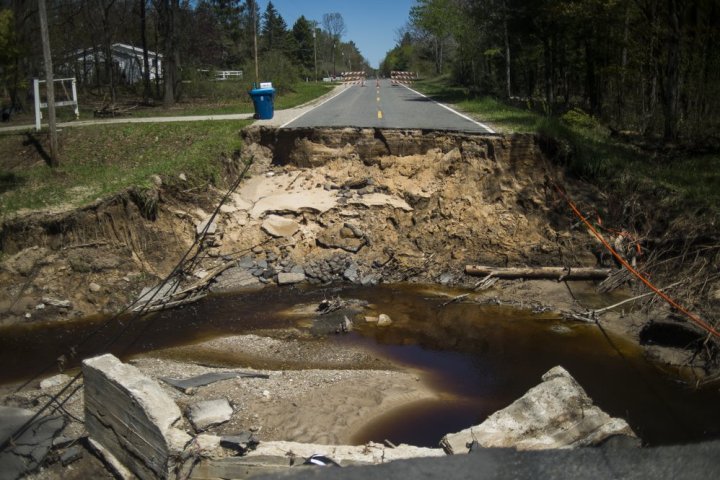[ad_1]

It took seven years to settle on a plan for cleansing two rivers and floodplains polluted with dioxins from a Dow Chemical Co. plant in central Michigan. The work itself has lasted nearly twice as long, with plenty still to do.
Now, scientists and activists fear some of the progress may have washed away with floodwaters that overwhelmed two dams this week, chasing 11,000 people from homes in and near Midland, the company’s headquarters city.
The Tittabawassee River flows past the Dow plant and eventually meets the Saginaw River, which continues into Lake Huron’s Saginaw Bay. That 80-kilometre stretch is tainted with dioxins — highly toxic compounds that researchers say can damage reproductive and immune systems and cause cancer. The area is on the federal Superfund list of hazardous sites.
Regulators and company officials said Thursday it was too early to tell whether the swollen river had damaged spots that had been repaired or swept pollutants farther downstream. Dow said it would inspect each cleanup location as floodwaters recede and sample for new contamination.
The projects “held up remarkably well” during a 2017 flood “and we are confident that we will see a similar outcome this time,” spokesman Kyle Bandlow said.
The U.S. Environmental Protection Agency said it would team with the Michigan Department of Environment, Great Lakes and Energy to evaluate any chemical releases from the plant, although Dow had reported none. Damage from the flood three years ago was “minimal” and required only minor repairs, EPA’s regional office in Chicago said.
But a similar outcome is unlikely after this week’s considerably bigger flood, said Allen Burton, a professor of environment and sustainability at the University of Michigan.
“There’s no reason to expect that everything would remain in the same place after a massive flood like this,” Burton said. “No scientist out there would predict that will happen.”
Erik Olson, a toxic chemicals specialist with the Natural Resources Defense Council, said floods produced by hurricanes have covered hazardous waste sites and carried contaminated wastes long distances.
“You can think you’ve contained toxic chemicals to a limited area, but a flood can scour that up and move it,” Olson said. “We saw that with Katrina. What happened there is exactly what we’re worrying about happening in Midland.”
In a report last year, the Government Accountability Office said EPA should take additional steps to safeguard Superfund sites from the effects of climate change, including flooding that might result from heavier downpours. It said 60 percent of Superfund sites not on federal property were vulnerable to floods, storm surge, wildfires, and sea level rise associated with global warming.
Dioxins are byproducts of some of the hundreds of chemicals manufactured over the years at the Dow plant, which began operating in 1897. It now produces silicones used in a variety of home and personal care products and electronics.
[ad_2]
Source link
Dear readers, we really need your support to keep on serving you with authoritative, truthful, and juicy stories everyday. For your support, please reach out to the editor @gavelinternational66@gmail.com

